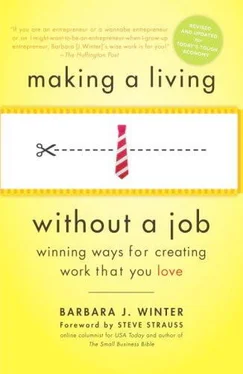• __More time with family and friends
• __Less structured lifestyle
• __More independence of thought
• __Opportunity to try own ideas
• __Recognition
• __Wealth
• __Less stress from demands of others
• __Curious about who I am and my untapped talents
• __More variety in my work
• __Time to think about personal philosophy
• __More nurturing relationships
• __Exploration of the unknown
• __More creativity
• __More satisfaction from work
• __Sense of being responsible and in control
• __Escape from frustration of carrying out someone else’s plan
• __Better use of talents
• __More time for travel, personal pursuits
• __Part-time work
• __Bigger contribution to society
• __Other (specify)
• Abraham Maslow, the psychologist who studied self-actualization, noted that all people who reached their fullest potential had a model in their life who inspired them. The idea of making a living without a job will seem less unusual if you raise your own awareness of others who have done it or are doing it. Pay closer attention to stories about self-bossers in magazines, in your local newspaper, and on television. These people can serve to inspire and educate you by their example.
Go even further and select a person, living or dead, whom you admire. Become an expert on that person’s life. Besides learning the facts of his or her personal history, scout for the underlying philosophy. What motivated this person? How did he or she view his or her contribution to the world? What sacrifices did your model make? What obstacles did he or she overcome? Why was this person special? Why are you inspired by him or her? My current study includes two very different women: Coco Chanel, the French designer, and Barbara Pym, the English novelist. Outwardly they have nothing in common, but their lives had several fascinating parallels. Both enjoyed early success, followed by a period of failure, followed by a stunning comeback. No, you are not too old to have heroes!
• Think about the idea of “making a life, not just a living.” What does that mean to you? Answer the following questions, keeping that idea in mind.
What would a balanced lifestyle include?
Where would you live?
How much time would you devote to working?
What nonworking activities are important to you?
What people would you spend time with?
What personal goals have you neglected that would become a priority again?
How would you express your values through your work?
Where would you volunteer time and resources?
How would you be involved with a cause or community?
How would your family or other significant people be included?
How would your daily life become richer?
What about your current life would you eliminate immediately?
What rewards other than money would you expect to receive from your work?
What skills do you most enjoy using?
How can you incorporate more positive experiences into your life?
What material things would you acquire? Give up?
• Start your own Living Without a Job notebook. A three-ring binder is perfect. Use it to trap ideas, store articles about interesting people and businesses, jot down quotes, etc. Fill your notebook with plenty of blank paper too, so that you can quickly add thoughts and inspirations as they come. Having a central location for idea-starters adds order and ease.
• A useful technique to employ in achieving any goal is that of creative visualization. You can use visualization daily to strengthen your determination, clarify your goals, and accelerate your progress.
Begin by setting aside a regular time every day to quietly create a mental picture of what you want to accomplish. Close your eyes, take several deep breaths, and picture a specific goal you want to achieve. You might, for example, have decided you want to put your love of gardening to work as a vocation, not just a hobby. In your daily visualization period, see yourself working out of doors, bringing beauty to different environments. Mentally, run through an ideal day—rising early, donning jeans and a T-shirt, jumping in your new Toyota pickup truck with your business’s name painted on the side. Visualize your clients exclaiming over your glorious landscapes. See them referring their friends to you, bringing you more opportunities to do the work you love so much. Include any ideas that appeal to you and run this mental movie over again and again. Keep adding details, color, smells, and sensory images.
Even if you aren’t yet clear about the specific ways in which you could be joyfully jobless, you can use visualization to create a clear picture of a happier, freer lifestyle. Use the thoughts you had in the earlier exercise about making a life, not just a living, as the basis for your visualization session. Taking time to do this regularly will bring great rewards in clarity and achievement. After all, visualization is nothing more than consciously creating a preview of coming attractions. It’s the way to manifest the adage “What the mind can conceive and believe, it can achieve.” Quite simply, creative visualization makes good things happen.
CHAPTER 3
Doing First Things First
Being yourself is not remaining where you are, or being satisfied with what you are. It is the point of departure.
Sydney J. Harris
During the mid-seventies, I moved to California, eager to investigate the Human Potential Movement, which was going strong at the time. I had heard rumors that there was a different seminar on every corner. It sounded like Nirvana for the self-help junkie I had become.
Once there, I was not disappointed. There was a dazzling array of personal development training to choose from. Besides the well-known est, Lifespring, and Dianetics, you could engage in Rolfing, Rebirthing, Primal Scream Therapy, Transactional Analysis, Silva Mind Control, dozens of meditation techniques, and various wild and wonderful therapies, many with clothing optional. Any respectable Californian could have her weekends booked for years. Everyone I met had indulged in at least one, and usually several, of these programs. Not only did I become an avid participant, I also attended many seminars as an observer. As a publisher, I received numerous invitations to come as a journalist in return for publicity in my newsletter.
Before long, I noticed a strong tendency in my fellow students. No matter what program they studied, once people had raised their self-esteem, they desired to be self-employed. Over and over again, in questionnaires filled out in class, in discussions during seminar breaks, or in letters to my newsletter, these students and seekers listed doing something on their own as a primary goal.
Psychologist Nathaniel Branden, a leading authority on self-esteem, made the same observation. “Productive achievement is a consequence and an expression of healthy self-esteem, not its cause,” he says. The link between self-esteem and successful self-bossing is so strong that it deserves to be a top priority for anyone who aspires to be joyfully jobless.
Until recently, nobody paid much attention to the importance of self-esteem. Our parents, for the most part, had no idea what it was or that it mattered. Unless they were rare creatures whose own self-esteem was in good repair, they did little actively to foster it in their children. I grew up in a home where criticism and sarcasm were considered appropriate parenting techniques—and that was not unique to my family. Sadly, that legacy continues for many adults today. When I complimented my daughter in front of relatives when she was younger, I was warned to be careful or she might get a big head. A much-quoted German proverb in our family carried a strong admonition: “Self-praise stinks!” With these repeated messages of self-denial as our guidelines, it’s little wonder that we wrestle with our self-esteem as adults.
Читать дальше












